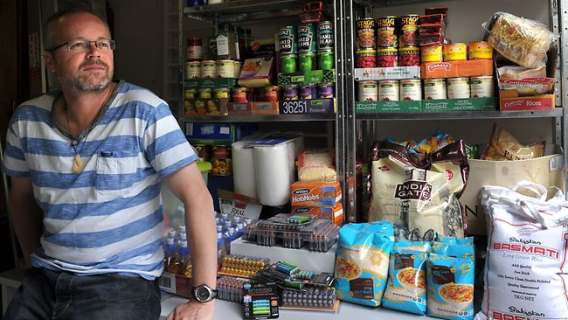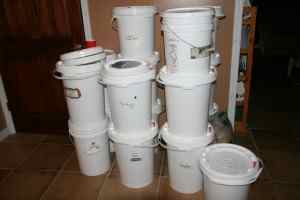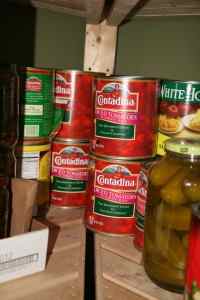Build Your Emergency Food Supply
Survivalists and grandparents tend to measure wealth differently than the Gameboy generation. If you’re the kind of person who’s concerned about emergency preparation, a large emergency food supply is true wealth. Just imagine a hurricane, flood, or earthquake that disrupts the infrastructure for several weeks. While the sheeple panic because the grocery store shelves are bare, you’re sitting pretty on a year’s supply of food. How does it feel? Why, it feels like opulence and abundance — wealth.
It’s Never Too Late To Build Up Food Stocks
We’re addressing a situation in which you’re basically hunkered down at your home, or else you’ve reached your bugout location. A foundational element of any emergency preparedness plan is the food stock. OK, your neighbor has a four-year stock, but it’s never too late for you to start. In fact, you probably have a three-day supply in your pantry, but we’ll get to that.
Food Stock Selection Principles
Before you build up your food stock, a few tips to keep in mind:
Make sure your selections are shelf stable. Canned and dry goods are best. In case of power outage, the freezer will keep your food for only two or three days. Don’t turn your nose up at processed foods; they tend to store longer, and while processed food is not as good for you as whole foods, it’s better than starving.
Stock food you will want to eat.
Stock dry and canned goods in a cool, dry, dark environment. Darkness is especially important if any of your canning is done in glass jars, because the light breaks down vitamins and protein in the food.
Variety is important. It prevents monotony and balances your diet.
Don’t shun convenience. Particularly for the short-term stocks (three days to two weeks), it’ll lift a great burden off your shoulders if you can just open a can and heat your meal, or eat something that’s good cold.
RELATED : NASA Warns California Drought Could Threaten U.S. Food Supply: “There will be some definite changes”
Small containers have a higher unit cost, but prevent waste (which is in itself costly).
Don’t make it too complicated. You certainly can go deep and calculate precise calorie and nutritional requirements, but if uncertainty is stopping you from getting something in the cupboard, then just simplify. Use an ancient, tried-and-true method — trial and error. We’ll come back to this.
Build Your Emergency Food Stock in Six Months
Building up a year-long food supply is a big endeavor, but you can do it by tackling this in three steps:
Week 1, build up a three-day supply
Week 2, build up a one-month supply
During the next five months, build up your one-year supply
Week 1 (right now!) — Get your three day supply. Most power outages are short, and a three day supply of dry and canned goods will get you through most thunderstorm-induced blackouts. First, check your pantry. You might well have a supply that will get your through three days without power or transportation. If not, a single trip to the grocery store can get you up and running. Here’s a suggested 3-day list (per person):
Can opener!
Trail mix – 8-ounce serving
Crackers – 1 box (8-ounces or larger)
Peanut butter – 1 (12-ounce) jar
Canned juice – 1 6-pack of 6-ounce containers
Peaches – 1 (8-ounce) can
Fruit cocktail – 2 (8-ounce) cans
Beans – 1 (8-ounce) can
Corn – 1 (8-ounce) can
Tuna – 1 (3 1/4-ounce) can
Beef stew or Chili – 2 small cans
Tomato or other soup – 1 can
Raisins or dried prunes – 2 12-ounce package
Mixed nuts – 1 package or jar
Tea and coffee – 1 box with 16 bags or 1 (2-ounce) jar instant coffee
Water – 1 gallon
Of course, if you have more than one person to stock for, combine quantities in larger containers to save on the unit cost. That is, buy a big jar of peanut butter instead of several small ones. Caveat: small quantities can still be useful, like small drink servings. You don’t waste as much. Also, there is a convenience factor here — you’re looking for a quick and easy way to get an emergency stock. Save the heavy calculations for your long-term survival stock.
Week 2 — Build up your one-month supply. There are too many differences from one household to the next to make a precise grocery list. But don’t worry, figuring what you need is fairly straightforward. Just see how much food you need to prepare a meal for your entire family, and multiply that by three to cover three meals a day. (If your family eats out at all during the month, this is more accurate than multiplying your weekly grocery-shopping by four). Then add 20% to cover errors.
Remember, it’s possible to get extremely precise about how many calories and what kind of foods you need, and by all means do so if you like. But if you don’t go to all this trouble, you still need something to eat, right? Here are some suggestions — add your own, of course:
Pasta. Spaghetti, macaroni, whatever. Great source of carbs, and everybody loves it. It’s not huge on vitamins, but that’s what canned fruit is for.
RELATED : SHOCK: 72 Hours After Grid-Down: Starvation, Supply Shortages, Food Lines, No Clean Water, No Gas
Canned fish. Salmon, jack mackerel, sardines, tuna, kippered herring. All these make great survival foods. Rich in Omega-3 fatty acids, protein, and flavor.
Dried beans and rice. Yes, there are lots of Y2K jokes about this, and I bet some of you still have some, eleven years later. But if you store them properly they will keep literally for decades. One interesting thing about beans and rice — together they make a “complete protein.” Rice has some of the amino acids that make up protein, and beans have the rest of them. Together, it’s great food.
Basic canned produce. Get a variety of beans (black, pinto, navy, kidney, and lima), vegetables (tomato, corn, and your favorite greens), and fruit (peaches, pears, apple sauce, or just a cocktail). These few items will cover nearly the entire gamut of vitamins, minerals, and fiber you’ll need long term, all while providing all the variety you’ll need to maintain morale.
Special canned produce. For an occasional treat, keep a few cans of blueberries, pumpkin pie filling, hearts of palm, capers, olives, or whatever your favorite canned goods might be.
Staples. Olive oil, flour, sugar, and salt. Buy them in bulk at Sam’s Club or Costco. Keep flour safe from mice and moths.
A long-term supply should go beyond basic survival —
a balanced diet and occasional treats are good for health and morale.
Month 2 through 6 — Build up your one-year supply. Now that you have a one-month supply, buy another two-month supply for each of the next four months, and a three-month supply the last month. When all is said and done, you’ll have everything you need to keep your family fed for a year.
But wait, it’s not over. You can keep having fun with this project almost indefinitely by undertaking a food stock management plan. We’ll take a look at this in the next article.
Survival MD (Best Post Collapse First Aid Survival Guide Ever)
Backyard Innovator (A Self Sustaining Source Of Fresh Meat,Vegetables And Clean Drinking Water)
Blackout USA (EMP survival and preparedness)
Conquering the coming collapse (Financial advice and preparedness )
Liberty Generator (Build and make your own energy source)
Backyard Liberty (Easy and cheap DIY Aquaponic system to grow your organic and living food bank)
Bullet Proof Home (A Prepper’s Guide in Safeguarding a Home )
Family Self Defense (Best Self Defense Strategies For You And Your Family)
Sold Out After Crisis (Best 37 Items To Hoard For A Long Term Crisis)
Survive The End Days (Biggest Cover Up Of Our President)
Drought USA(Discover The Amazing Device That Turns Air Into Water)
SOURCE : www.survivalnewsonline.com






